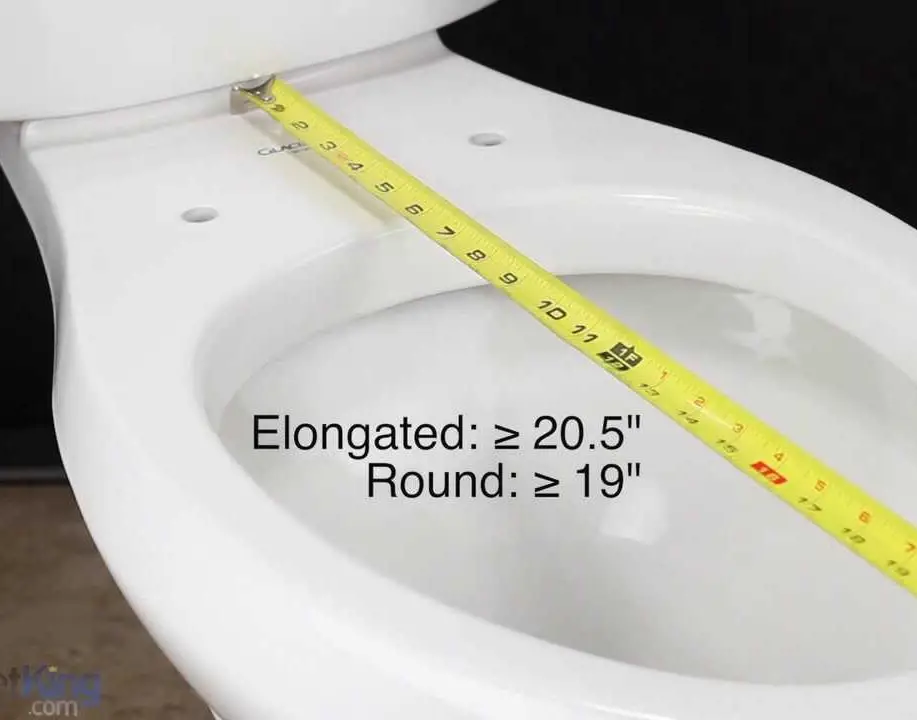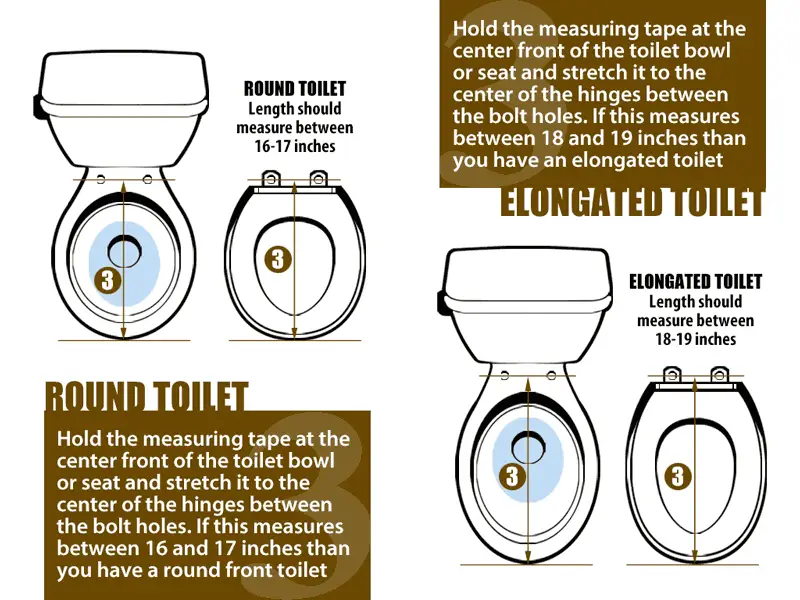How to Measure for a Toilet Seat [The Easy Way]

It’s time to get a new toilet seat. Maybe, your toilet seat is worn or broken, or you’re redecorating. Whatever the case, you need to measure for a new toilet. How do you measure?
To measure for a new toilet seat, the primary measurement you need is from the center of the seat’s bolt holes to the very front lip of the toilet. Generally, this will be enough for a standard household toilet seat.
Generally, household toilets are manufactured for two different standard sizes of seats. So if your toilet is a standard household variety, chances are high you have one of these two sizes. These are:
Rounded: These seats are named for their more rounded shape and measure 16.5” from the bolts to the front.
Elongated: These seats are aptly named for their longer length back to front and measure 18.5” from bolts to the front.
If it is not one of these sizes, generally, you will need a specialty size of toilet seat.
To measure for your toilet seat, you will want to measure several dimensions to ensure that the seat fits and opens smoothly. To do this, follow these steps.
Remove the old seat. If the old seat is present, you will often need to raise plastic covers that snap over the bolts. Generally, you will now use a screwdriver to rotate the bolts. Rotate them counterclockwise while using a wrench or pliers to hold the nuts still on the bottom.
Measure the distance from back to front. Use a measuring tape to measure from the center of the toilet between the two bolts that hold the seat to the very front of the toilet.
Measure the width of the toilet bowl. Most toilets have about the same width, but it is a good idea to measure it anyway. Your seat will need to go over the outer rim and leave enough room inside the bowl.
Measure the width between the center of the two bolt holes. Generally, this will be a standard 5 ½” for standard American toilets. However, for European toilets, this will typically be 6” to 6 ½”. Toilet seats that do not match these bolt hole measurements may require custom work.
Measure the distance from the center of the bolt holes to the tank. This is particularly important for specialty toilet seats. This will ensure that the tank does not prevent a fit, or if necessary, the seat raising.
For a snap-on toilet, seat attachments measure the old seat. This includes both the length and width of the existing seat.
Write these measurements down. You will want to bring them with you to the store when selecting your new seat.

When it comes time to replace your toilet seat, you have several options to choose from. So, just think about your needs. You have different types, shapes, colors and decorations, and materials, so a lot to consider.
Types: Stores offer many types of toilet seats for special needs or convenience.
Raised seat: This seat is higher, making it a good choice for people who have trouble getting up and down. People recovering from knee surgery may find this convenient and there are several options for these.
Open Seats: These are generally a legal requirement for public toilets in the United States. However, they can be a good choice for those with a lot of guests or those concerned with hygiene. They possess an open front leaving them with an u shape to leave room for wiping and to prevent urine drips.
Soft closing: These toilet seats are great for homes with children who may slam the toilet seat. They have machinery inside the hinge assembly, making the toilet seats fall into place slowly. They do not require any difficult installation, and they typically have a slightly larger hinge assembly.
Bidet seat: These toilet seats are growing in popularity across the world, and offer a bidet built into the toilet seat. These typically have a bracket installed into the bolt holes. They also have a removable seat that connects to the tank’s water supply.
Heated seat: These seats originated in Japan but have become popular around the world. They attach to the toilet like an ordinary seat. However, they require a GFCI outlet for power and are simply plugged in.
Most manufacturers produce household toilets for two standard size toilet seats. However, if your toilet is for a commercial building, these are often smaller and may measure 15.8” from bolt holes to front lip.
Also, toilets made for RVs are typically even smaller, in addition to functioning very differently. These often measure between 12” to 13”.When purchasing toilets in these situations, purchase one designed for your toilet or measure for a new one.
Most toilet seats are between 14” to 15” inches from the floor. However, toilets designed for juveniles can be as low as 11”.
Toilets designed for the elderly, individuals with disabilities, or even those with recent surgery are typically higher. Sometimes this is achieved with special seats or other aftermarket adapters. But toilet manufacturers have responded to the demand and started manufacturing toilets with greater heights.
These toilets place less strain on the knees and are designed to mimic the height of a chair. These are generally between 16” to 18”. This puts it within the Americans with Disabilities Act guidelines of 17” to 19” of height from the floor.
No, not all toilet seats fit the same. Although there are industry standards, manufacturers can make different sizes of toilet bowls that come with their own proprietary seats.
However, most toilet bowls are standard round or standard elongated, and any standard manufacturers’ seats will work for these toilets.
No, you cannot replace a round toilet seat with an elongated toilet seat. A round bowl is two inches shorter than an elongated bowl, so the seats are not interchangeable.
Generally, a top fixing toilet seat fitting uses an insert that the bolt on top goes into. This most often forces the insert to expand, thereby gripping the sides of the hole.
This will secure the fitting in place for the seat. To remove this, simply unscrew the bolt and pry the insert out. A flathead screwdriver can often help as the fitting can be quite snug.